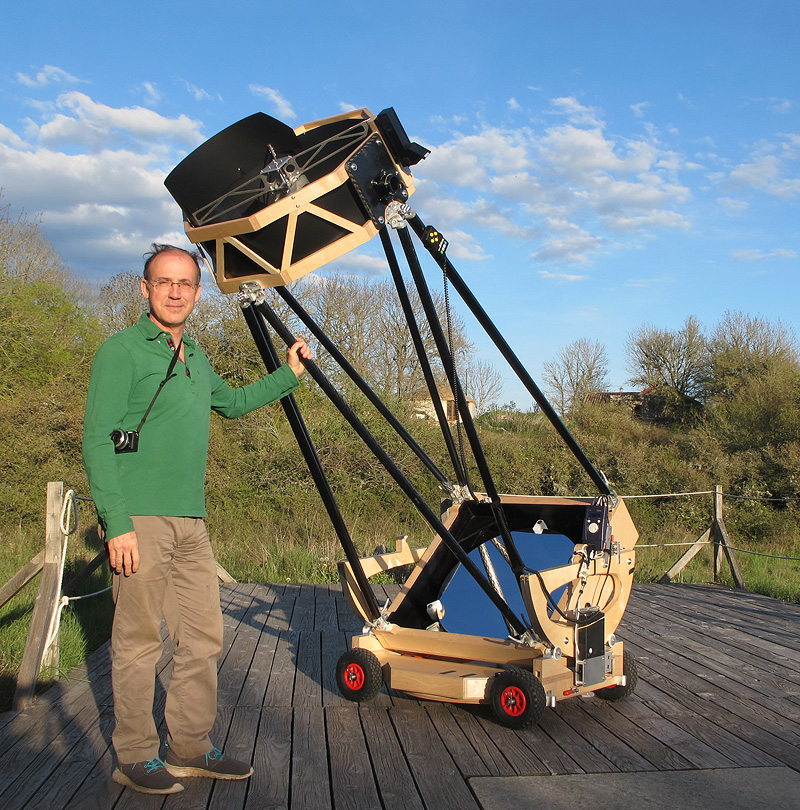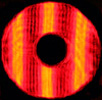March 19, 2017: A telescope built in France for a Swiss client
All text and images copyright Michael E. Lockwood, all rights reserved, unless otherwise noted.
I have clients all over the world, and probably the greatest concentration of those clients outside of the United States would be in Europe. There are some very dedicated, creative, and skilled telescope builders in Europe, and they each have their own way of building a structure to support the optics that I have made. Said another way, each builder's instruments have a different personality.
In 2015 I was able to visit a Swiss client who had purchased a 28" f/3.5 mirror and matching flat. I had not yet made the mirror, and it was completed in 2016. The client decided to have Frédéric Gea, of Stellarzac in France (web site in French, of course), build the structure. The beautiful result of this is shown below, along with the happy owner. Thank you to Frédéric and Stéphane for the use of his photos in this article.

For more photos, see link here: Frédéric's blog entry - 28" telescope photos
Frédéric is very pleased with the optics and the telescope performance. See his other blog entry for his description of the first night using the telescope and the magnifications used and objects viewed: Frédéric's blog entry - 28" first light and observing
With his permission, I have also included an English translation of that blog entry at the bottom of this article.
 He
was pleased enough with the performance to do some planetary imaging
recently, and the results are seen here at right - it is a superb image
of Jupiter! He used an ASI224
color camera, a 4X Powermate, and an atmospheric dispersion corrector
(ADC)
to correct for the "rainbow effect" of the atmosphere when we view
through it at an angle.
He
was pleased enough with the performance to do some planetary imaging
recently, and the results are seen here at right - it is a superb image
of Jupiter! He used an ASI224
color camera, a 4X Powermate, and an atmospheric dispersion corrector
(ADC)
to correct for the "rainbow effect" of the atmosphere when we view
through it at an angle.Keep in mind this observing is from southern France, and Jupiter is not as high up as it has been in the recent past, and it is not as high as in much of the US!
When the atmosphere calms down, I have always had superb planetary observations through large, fast instruments. In fact, my best views ever of Mars, Jupiter, and Saturn have been through a 32" f/3.6 that I made the optics for. There is no reason why they can't perform on planets if the optics and telescope are built properly, and clearly this one is.
What is also interesting is that most planetary imaging is done with smaller reflectors, usually at largest around 16" in aperture. (One reason is that it is easier to handle thermal issues with these instruments.) This is one of the first times I've seen someone try to image with such a large, fast instrument, and the results clearly show what the telescope is capable of. Someday I would like to try this at the Winter Star Party with a 32" f/3.6, but we just haven't quite managed to do it yet!
So, there you go, a superb instrument built by a skilled builder in France, and more proof that large, fast telescopes (with quality optics) can produce superb images of planets.
For another telescope built by Frédéric using my optics, see his blog entry about a 30" f/3.6 that he built in 2016 for a French client. Frédéricc and the client are very pleased with those optics, too, and have used them at high power.
I look forward to visiting both clients to see the 28" f/3.5 and 30" f/3.6 when I have time to make a return trip to Europe in the future. See Frédéric's translated blog entry text just below for more information on first light with the 28" (711mm) telescope.
Please check back for future installments of "In the Shop".
Mike Lockwood
Lockwood Custom Optics
From the blog of Frédéric Gea, link given above, with permission, translated by Google:
"It takes hundreds of hours of work to get to the first light of an instrument, and for that 711, it is tonight 22 February. The day before I take the opportunity of the presence of Frédéric Burgeot (http://fredburgeot.fr/) to install the primary mirror of 48 kilos on the mirror cell, assemble the whole structure, and make a first collimation, but the evening weather was not favorable to the first tests.
I usually do the first lights alone on the platform, but Fred Burgeot is there to draw at the eyepiece of the 40", and this will be the opportunity to share this intense moment of the official birth of an instrument. This test on the sky is always a stressful moment. Are there any design or construction errors? Will the focus point be at the chosen position? Will the movements be good ? Constant balancing? Are the optics good? Few minutes to wait for the answer to these questions ...
The installation is very fast, the instrument is rolled to the "east" concrete pier, the central pier being used for the 40".
The night begins to settle and to easily adjust the telrad, a great target is in the sky, Venus. Ethos 13 mm slipped in the Paracorr, the celestial bright light is aimed. At the first seconds, I feel how easy is to move the instrument and when the planet appears in the field, I see that the optics will be a match. Despite its low position, the Venus is superb, contrasted, the beautiful crescent is nicely cut on the sky. Quick adjustment of the telrad, it is time to point a star to adjust the mirror cell. At the theoretical position of the counterweights, the image is great, the reactions of the cell and the structure are very good.
The alignment of the Argonavis is done without problem and a check of pointing accuracy is done on... M42. The Ethos 21 mm gives a magnification of 136x, the beautiful nebula perfectly framed in the field. The contrast is excellent and the palette of visible colors impressive. Must see in the winter sky, the Clown, NGC 2392, but to ease observation, I start the tracking (StellarCat). The calculated ratios are close to real parameters but I will adjust them to eliminate a small drift I notice. The seeing is great at 360x, the central star is a tiny pinpoint. The Takahashi 5mm makes the magnification rise to 575x ... and does not change the sharpness of the image, the central star is always point like ... bluffing! Quickly, the Televue zoom is in the FeatherTouch Focuser ... at 720x, it's still incredibly good! You have to push the zoom to more than 1000x to start seeing a "degradation" of the central star.
Jupiter is still very low but the temptation is too great, back to a 13 mm Ethos to start and it is the confirmation of previous observations, the sky is very good and the instrument lived up to expectations. The image is beautiful but atmospheric dispersion limit the instrument performance. Quick disassembly of the photo configuration to be able to use the atmospheric dispersion corrector (ADC) in combination with Powermate 4x / Panoptic 24 mm, the resulting magnification is around 420x. How beautiful! Unreal so low in the sky! I can not hold back calling Frederic Burgeot to share the view, I have scruples because he draws weak objects but he must see these images. He is not disappointed by this image.
The temptation is too great, placing the ASI224mc in the focuser to have an idea of the potential of the instrument . On screen the pictures are very beautiful but I am the weak link of the chain. The PC has been reinstalled recently and I no longer have my usual version of Firecapture, and I haven't used if for months. It doesn't matter, I got to find my marks as Jupiter is climbing higher. Recording some videos at abnormally low FPS, the PC is yet equipped with an SSD. At last I find that I have forget to turn on the fastusb parameter but it is the bad surprise, the seeing is no longer good, impossible to recover the sharpness of the beginning. It is a disappointment but I should have been more prepared ...
End of the night at 4:30, tired but happy to see that this 711 is a great instrument ... The good news is that he is going to be in Stellarzac for a while, his owner can not host it at the moment, it is therefore present on the platform of observation for an undetermined period. Its owner will be at Stellarzac to use it and visitors will be abble to use it on the platform. Icing on the cake, it I will have the pleasure to use for astrophotography! To be continued!
Thank you, Frédéric."



